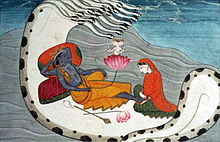Adishesha
| Shesha | |
|---|---|

|
|
| Resemblance | Snake |
| Affiliation |
Vishnu Nāga Lakshmana Balarama |
In Hinduism, Shesha (Sanskrit: Śeṣa), also known as Sheshanaga (Śeṣanāga) or Adishesha (Ādi Śeṣa), is the nagaraja or king of all nāgas and one of the primal beings of creation. In the Puranas, Shesha is said to hold all the planets of the universe on his hoods and to constantly sing the glories of the God Vishnu from all his mouths. He is sometimes referred to as Ananta Shesha, which translates as endless-Shesha or Adishesha "first Shesha". It is said that when Adishesa uncoils, time moves forward and creation takes place; when he coils back, the universe ceases to exist.
Vishnu is often depicted as resting on Shesha. Shesha is considered a servant and a manifestation of Vishnu. He is said to have descended to Earth in two human forms or avatars: Lakshmana, brother of Rama; Balarama, brother of Krishna.
"Shesha" in Sanskrit texts, especially those relating to mathematical calculation, implies the "remainder" — that which remains when all else ceases to exist. But in Sanskrit it also means 6 shesham as the sheshanaga has been depicted to have many heads (5 to 7).
Shesha is generally depicted with a massive form that floats coiled in space, or on the ocean of bliss, to form the bed on which Vishnu lies. Sometimes he is shown as five-headed or seven-headed, but more commonly as a many thousand-headed serpent, sometimes with each head wearing an ornate crown.
His name means "that which remains", from the Sanskrit root śiṣ, because when the world is destroyed at the end of the kalpa, Shesha remains as he is.
...
Wikipedia
